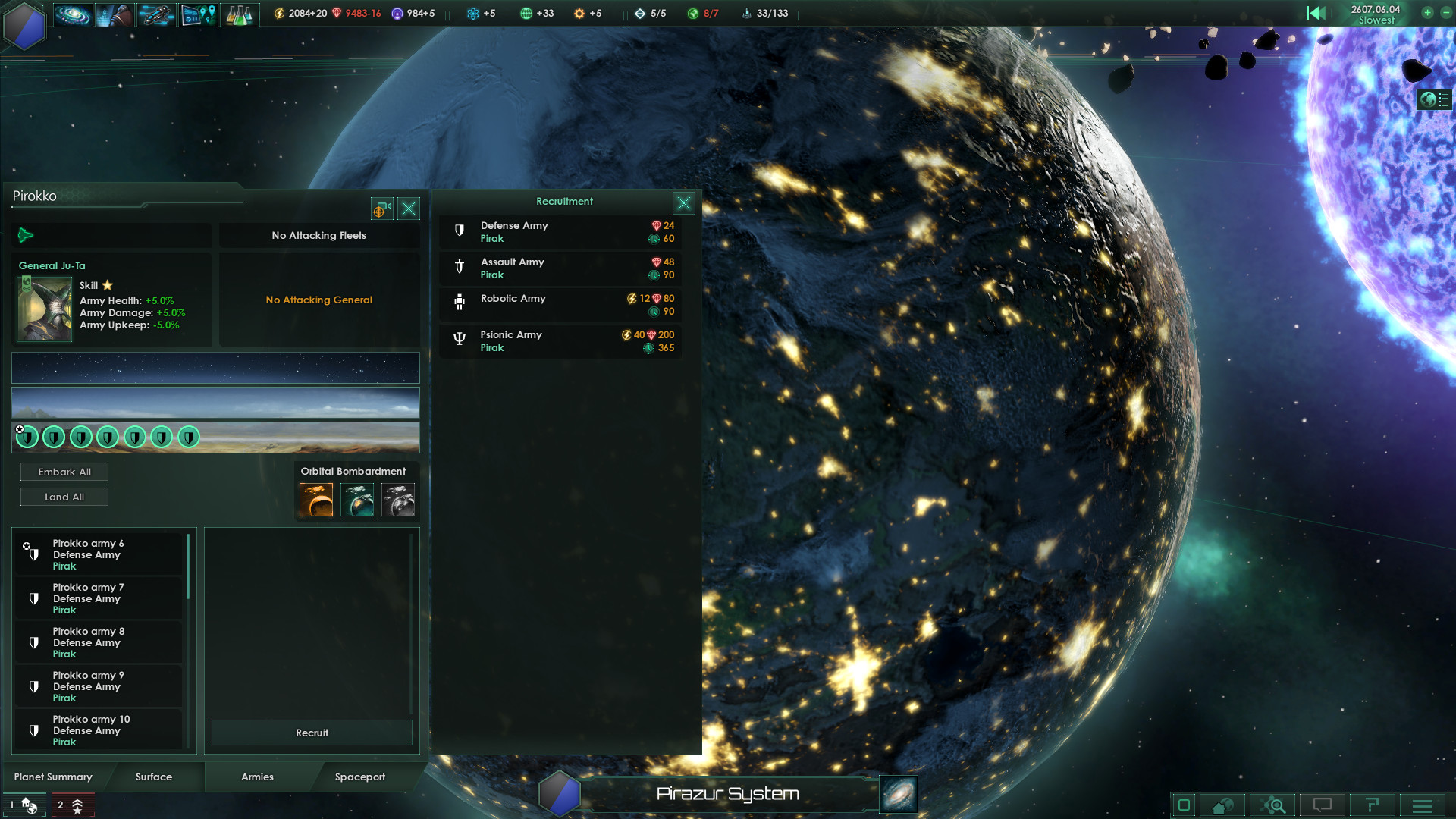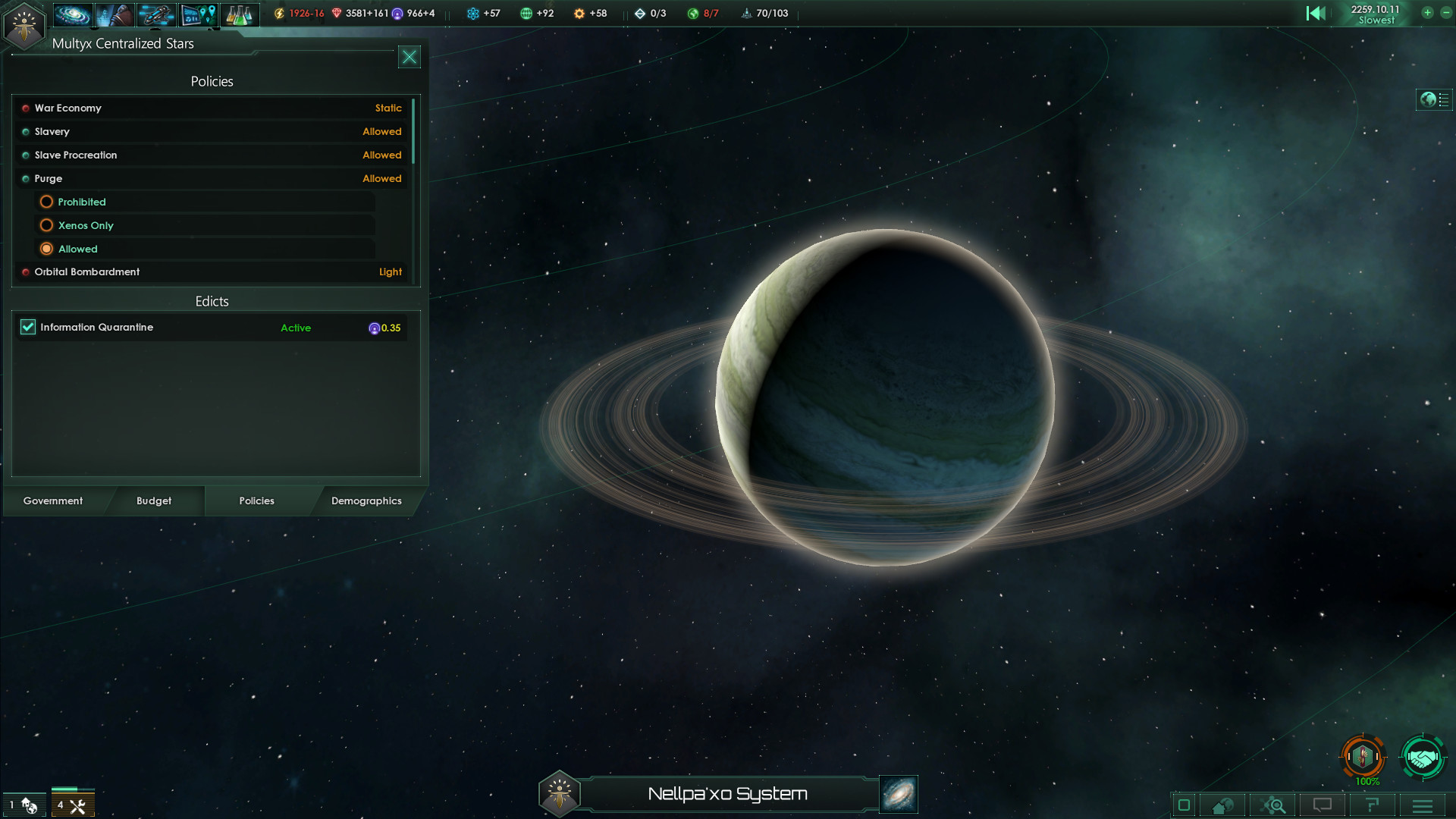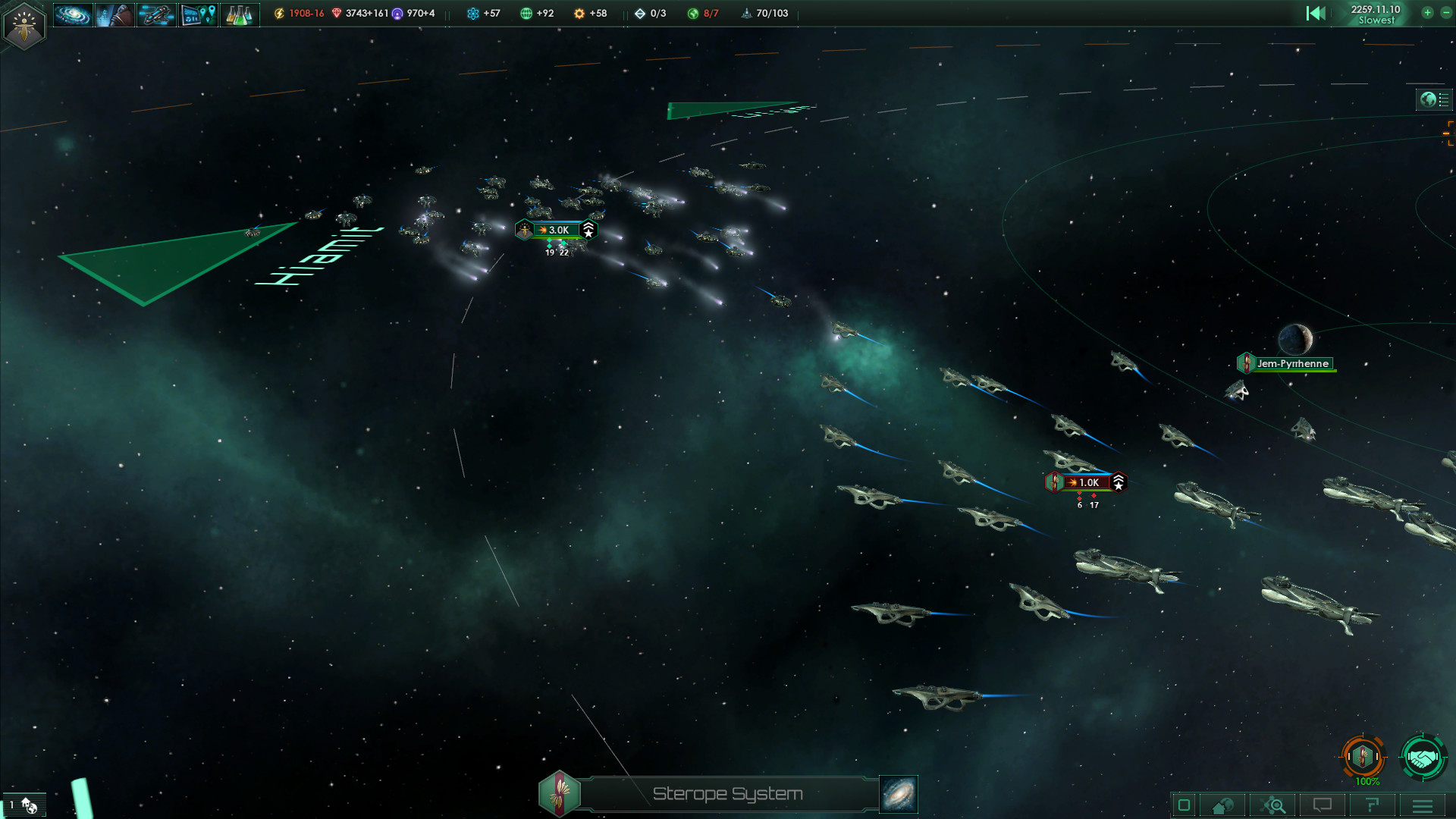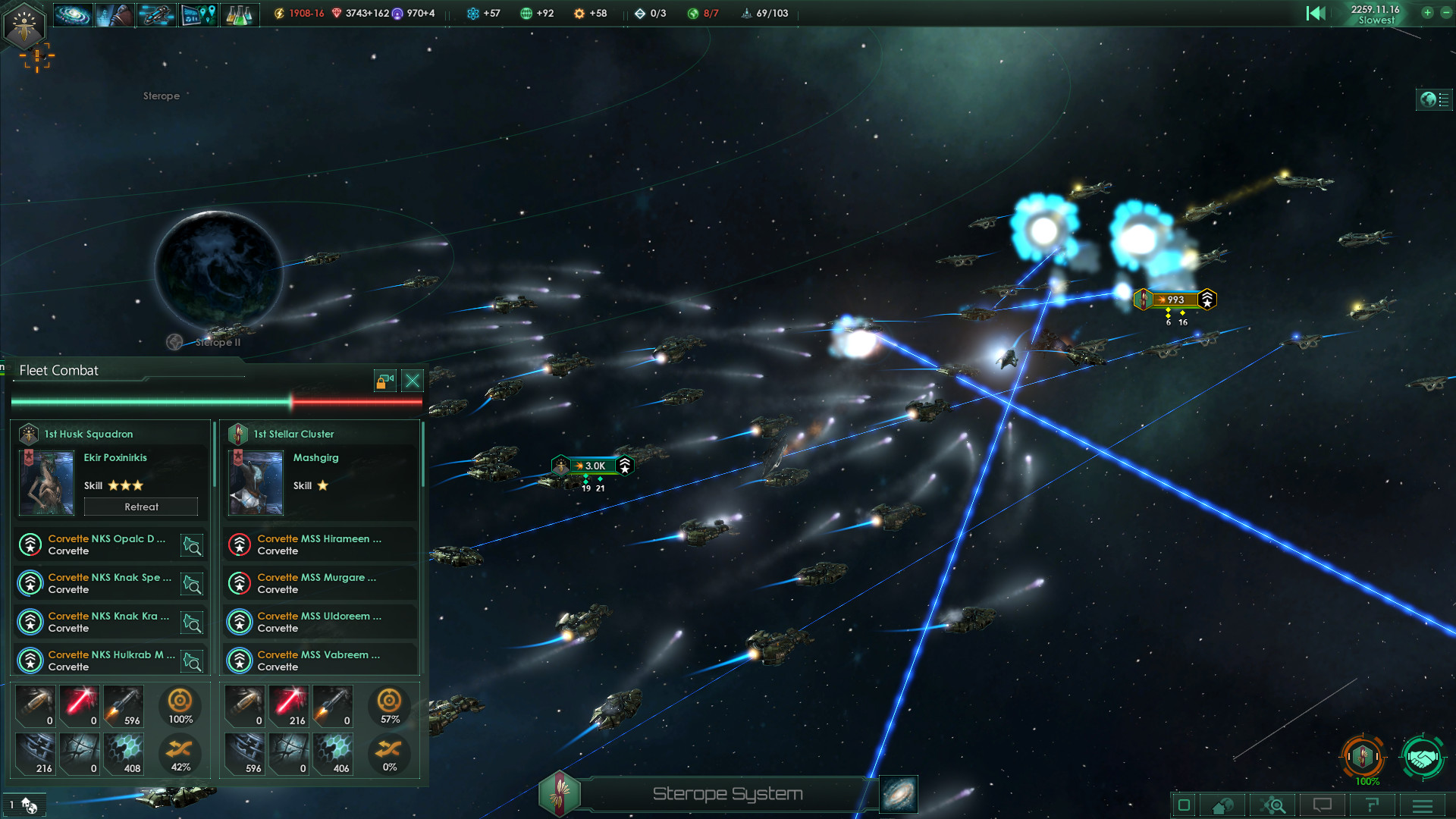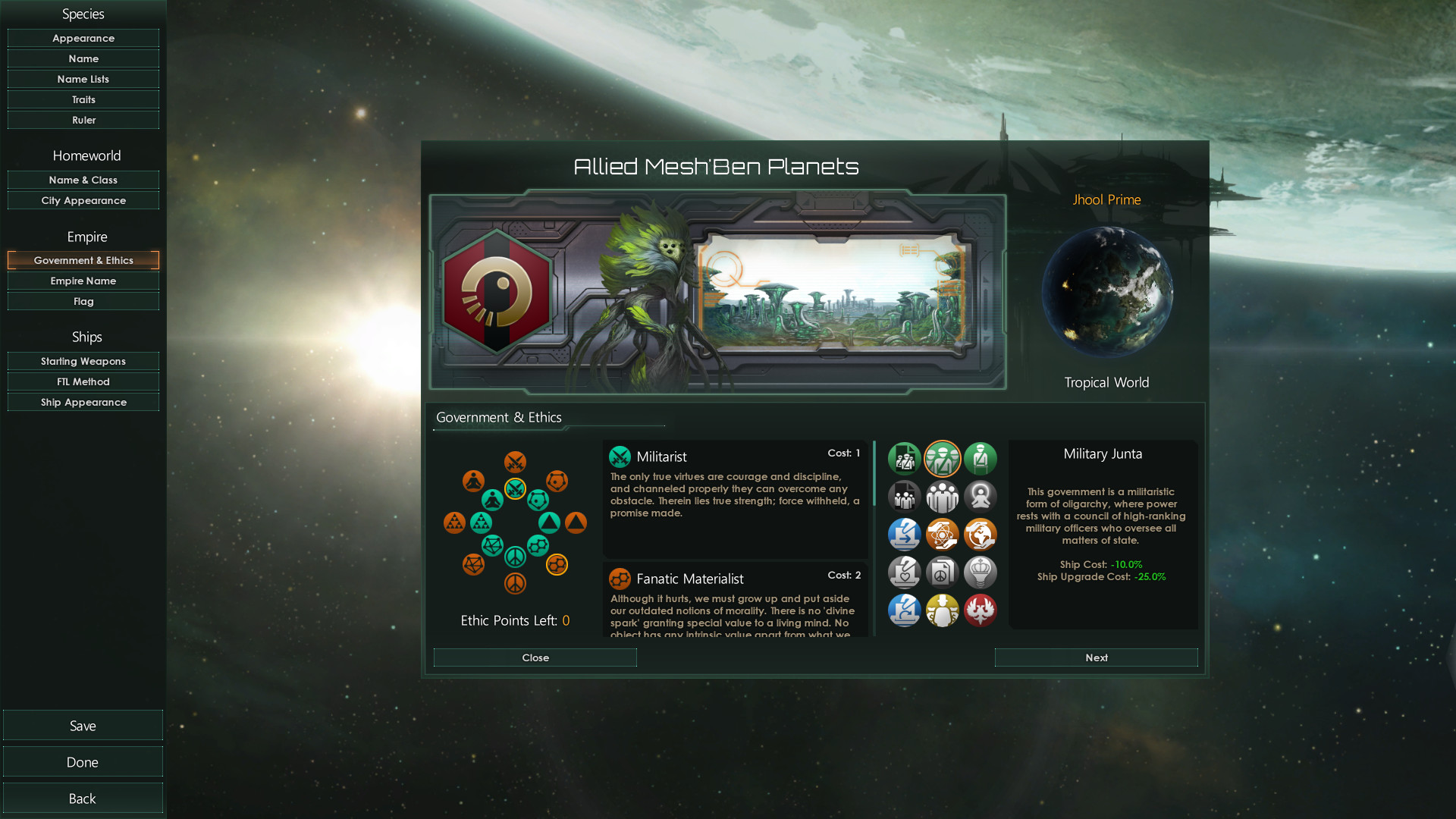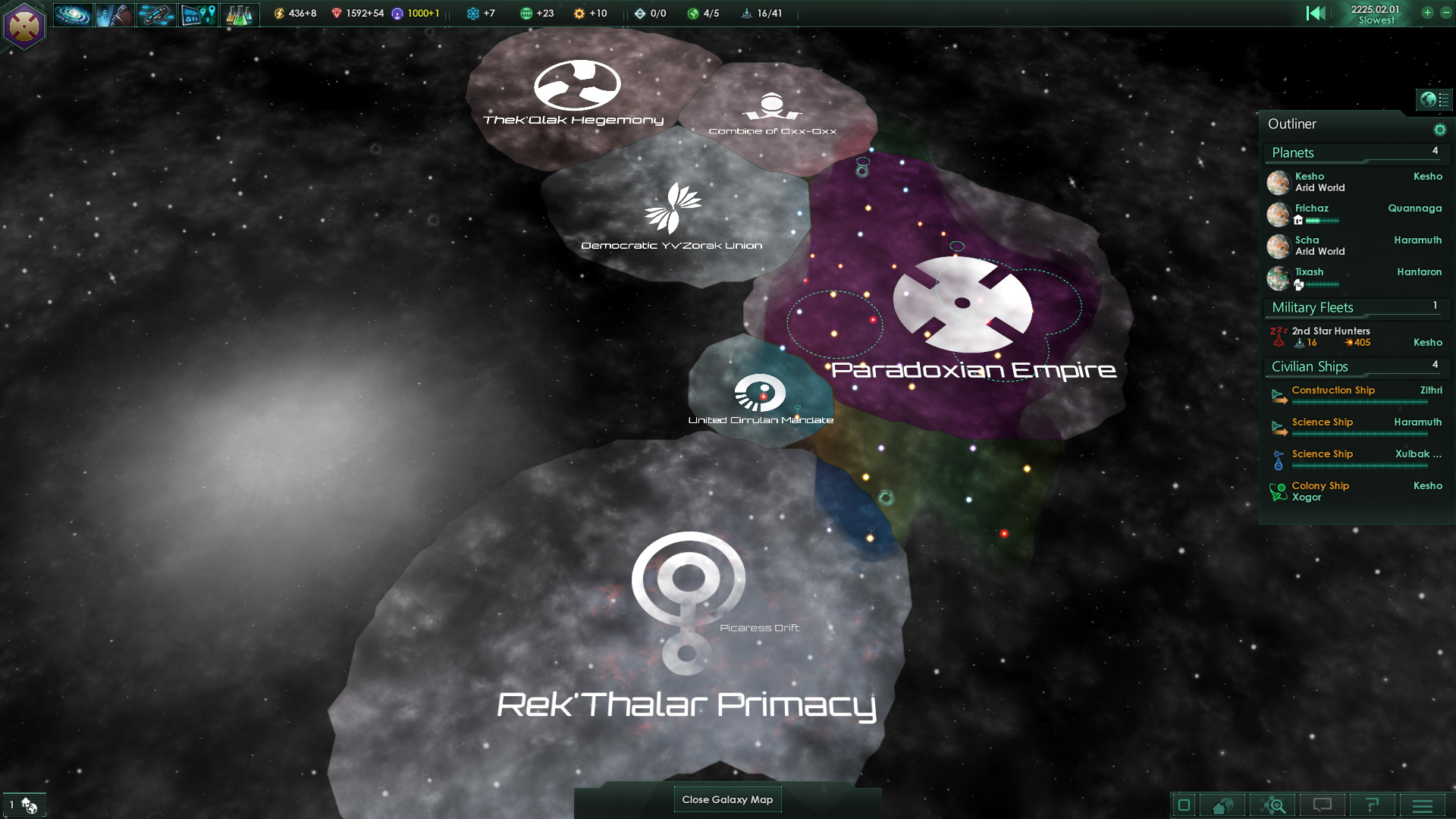Featuring deep strategic gameplay, a rich and enormously diverse selection of alien races and emergent storytelling, Stellaris has engaging challenging gameplay that rewards interstellar exploration as you traverse, discover, interact and learn more about the multitude of species you will encounter during your travels.
Etch your name across the cosmos by forging a galactic empire; colonizing remote planets and integrating alien civilizations. Will you expand through war alone or walk the path of diplomacy to achieve your goals?
Main Feature
- Deep & Varied Exploration.
- Enormous procedural galaxies, containing thousands of planets.
- Explore Anomalies with your heroic Scientist leaders.
- Infinitely varied races through customization and procedural generation.
- Advanced Diplomacy system worthy of a Grand Strategy Game.
- Ship Designer based on a vast array of technologies.
- Stunning space visuals.

Hello everyone and welcome to another Stellaris development diary. Today, we're going to start talking about the Planetary Rework coming in the 2.2 'Le Guin' update - the complete redesign of the planetary management system and replacement of planetary tiles. This is going to be a really big topic, so we're spreading it out across four dev diaries, with today's dev diary being about Deposits, Buildings and Districts. Please bear in mind that everything shown is in an early stage of development, and there will be rough-looking interfaces, placeholder art, non final numbers and all those things that people assume are final and complain about anyway no matter how many of these disclaimers we write! ;p
Planetary Rework
Before I start going into details on the actual rework, I just wanted to briefly talk about the reasons and goals that are behind this massive rework, and why we're removing tiles and building a new system instead of iterating on the existing systems. For me, getting away from the constraints of tiles has been my single most desired long-term goal for the game. It's not that I think the tile system is inherently a bad system - it works well to visualize your pops and buildings and for the early game it works well enough in giving the player some interesting economic management decisions. However, the tile system is also very constrictive, in a way I feel is detrimental to the very core concepts of Stellaris. The hard limitation of one pop and one building per tile, as well as the hard limitation of 25 tiles/pops/buildings to a planet, it severely limits the kind of societies and planets that we can present in the game.
Do we want to make city-planets, with enormous numbers of pops concentrated onto a single world? Not possible. Do we want to have a fully automated post-scarcity empire where robots do all the actual work? Can't be done without losing out on valuable building space. Sure, we could fundamentally alter the tile system in a such a way to allow these, by for example making it so each tile could support several sub-tiles with additional pops and buildings, but by doing this we will inevitably lose the easy visual presentation that makes the system attractive to begin with, and even then we would continue to be held back by the limit of one pop per building. In other words, we'd end up with something that superficially might resemble the old tile system but offers none of its main advantages and continues to be held back by most of its drawbacks.
When designing the new planetary management system we set out a number of design goals:
- The new system should be able to simulate a wide variety of different societies, to build on the roleplaying and diversity in play-throughs that is such a fundamental part of the Stellaris experience
- The new system needed to offer more interesting choices about how to develop your planets, while simultaneously reducing the amount of uninteresting micromanagement such as mass-upgrading buildings
- The new system should make your planets feel like places where Pops actually live their lives, as opposed to just being resource gathering hubs
- The new system had to be extremely moddable, to make it easier both for us and modders to create new types of empires and playstyles
Deposits
Under the old tile system, deposits were simply clumps of resources placed on a tile, which would be gathered by a pop and determined what kind of buildings were most efficient to place there. Under the new system, deposits are more akin to planetary terrain and features. Every habitable planet will have a (semi-randomized) number of deposits, with larger planets usually having more deposits. Deposits represent areas on the planet that can be economically exploited, and most commonly increase the number of a particular District (more on this below) that can be build on the planet. For example, a Fertile Lands deposit represents various regions of fertile farmland, and increases the number of Agriculture Districts that can be built on the planet, and thus its potential Food output.
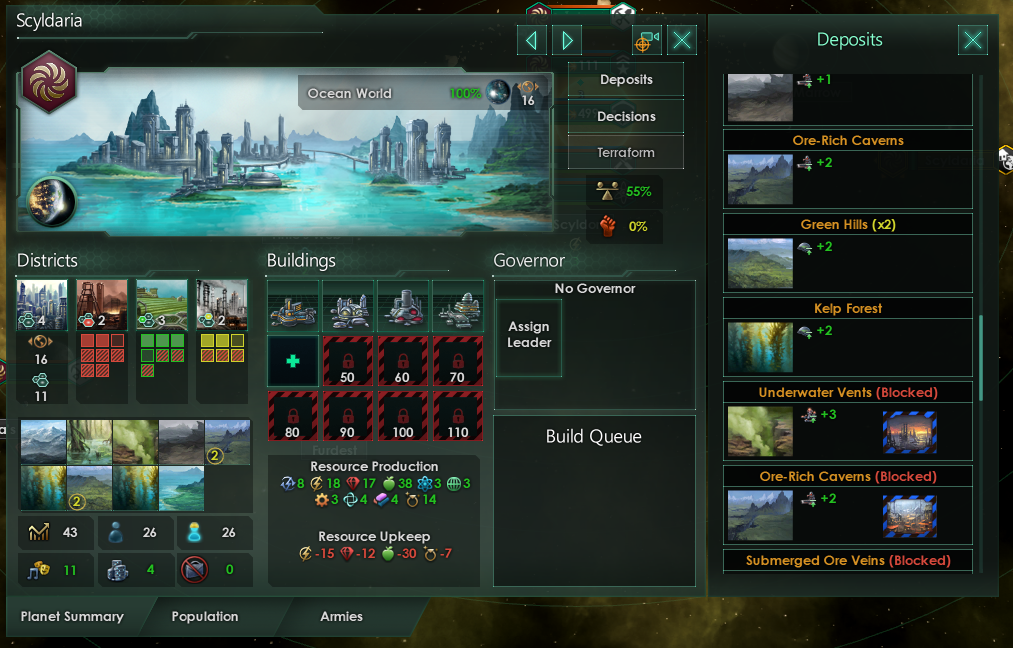
(Note: All deposit pictures shown here are placeholders, there will be new art for them that isn't done yet)
Not all Deposits affect Districts however - some (such as Crystalline Caverns or Betharian Fields) are rare deposits that allow for the construction of special Buildings (more on this below) on the planet, while others yet may simply provide a passive benefit to the planet, such as a spectacularly beautiful wilderness area that increases happiness for Pops living on the planet. Deposits can have Deposit Blockers that work in a similar way to the Tile Blockers of old, cancelling out the benefits of the Deposit until the Blocker is removed through the expenditure of time and resources. A planet can have multiples of the same Deposit, and there is no hard limit to the number of Deposits that a planet can hold (though there is a cap to how many will be generated under normal circumstances). The types of Deposits that can show up on a planet is affected by the planet class, so where an Ocean World might get its Agriculture from Kelp Forests, an Arctic World would have Fungal Caverns instead.
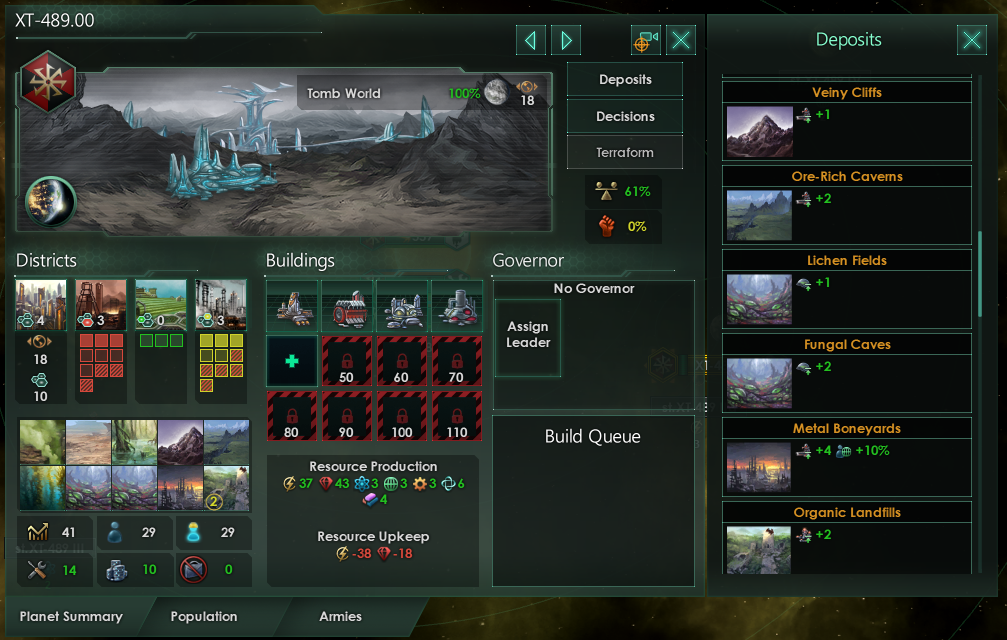
(Note: All deposit pictures shown here are placeholders, there will be new art for them that isn't done yet)
Districts
Districts are at at the core of how planets are developed in the Le Guin update. Districts represent large areas of development on the planet dedicated towards housing or resource gathering. For most empires, there are four basic types of Districts: City Districts, Mining Districts, Generator Districts and Agriculture Districts. There are exceptions to this (such as Hive Minds having Hive Districts) but more on this in a later DD. The total number of districts you can build on a planet is equal to its size, so a size 16 planet can support 16 districts in any combination of the types available to you. Additionally, the resource-producing districts (Mining, Generator and Agriculture) are further constrained by the Deposits on the planet, so a planet might only be able to support a maximum of 8 Mining Districts due to there simply not being any further opportunities for mining on the planet. City Districts are never limited by the deposits on the planet, so you can choose to forego a planet's natural resources and blanket it entirely in urban development if you so choose.
The effects of each District is as follows:
- City District: Provides a large amount of Housing for Pops, Infrastructure for Buildings and Clerk Jobs that produce Trade Value and Luxury Goods
- Mining District: Provides a small amount of Housing/Infrastructure and Mining Jobs that produce Minerals
- Agriculture District: Provides a small amount of Housing/Infrastructure and Farming Jobs that produce Food
- Generator District: Provides a small amount of Housing/Infrastructure and Technician Jobs that produce Energy Credits
A planet's Deposits and Planetary Modifiers may influence this decision - a large planet with High Quality Minerals and numerous Mining Deposits will certainly make for a lucrative mining world, but what if it also sits in a perfect spot to make a heavily urbanized trade hub? No longer are choices regarding planets simply limited to 'Where do I place the capital for the best adjacency bonuses?' and 'Should I follow the tile resource or not?' but will be fundamental choices that create diverse and distinct planets that each have their own role to fill in your empire.
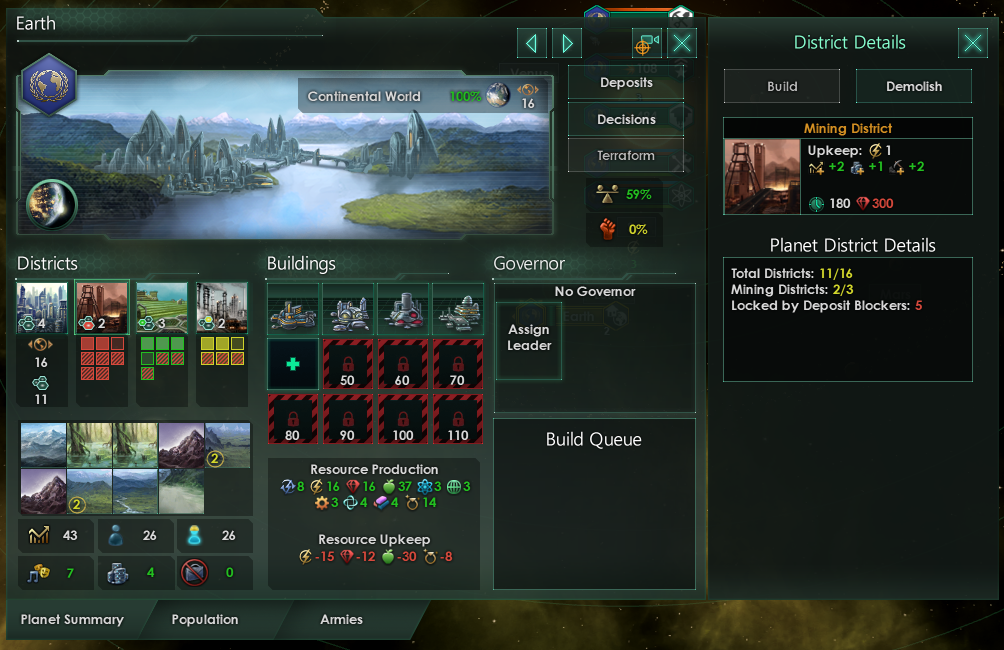
Buildings
In the Le Guin update, Buildings are specialized Facilities that provide a variety of Jobs and Resources that are not suitable to large-scale resource gathering. For example, instead of having your scientists working in a Physics Lab on a Physics Deposit (whatever that is supposed to be...) you now instead construct a Research Labs building (representing not a single laboratory but rather an allocation of resources towards the sciences across the planet) which provides a number of Pop Researcher Jobs that conduct research for your empire. Buildings are limited by the planet's Infrastructure, with one building 'slot' being unlocked for each 10 Infrastructure on the planet. Some Buildings are also limited in the number you can build on a planet, while others can be built in multiples (for example, a planet can only support a single Autotchton Monument, while you can have as many Alloy Foundries as the slots allow). Buildings can still be upgraded to more advanced versions, but generally there will be far fewer upgrades to do and those upgrades will often require an investment of rare and expensive resources, so it's more of an active choice than something you simply have to click your way through after unlocking a tech.
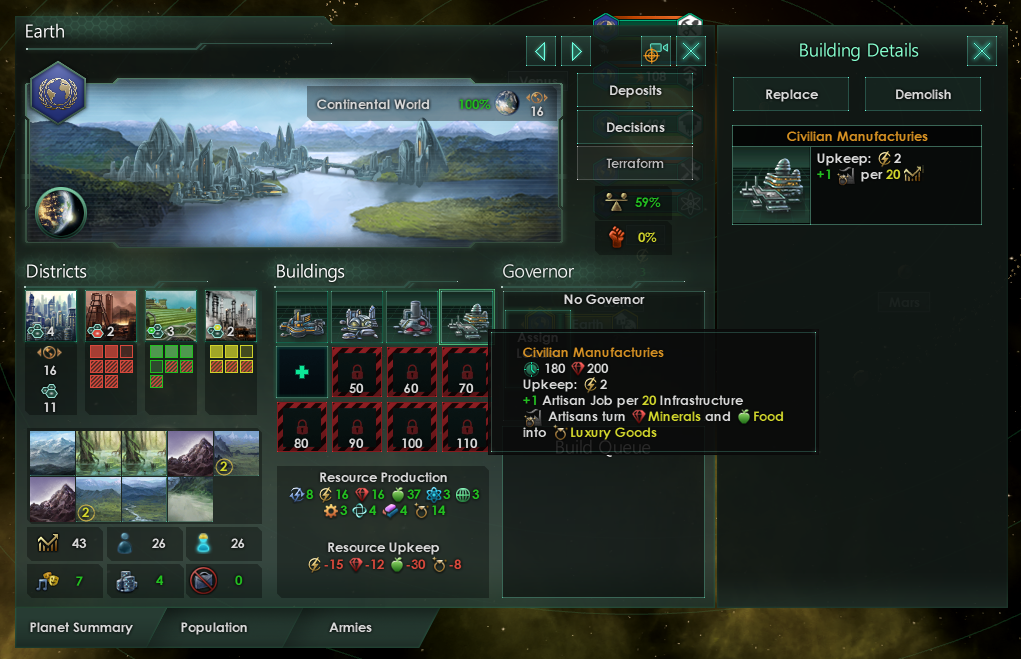
Infrastructure comes primarily from constructing Districts, with City Districts giving much more Infrastructure than resource gathering districts do (6 as opposed to 2 in the current internal build, though non final numbers and all that). In addition to unlocking additional Building slots, a higher Infrastructure level also makes some Buildings more efficient, as the number of jobs they provide is fully or partially determined by the planet's Infrastructure level. For example, in the current internal build, Research Labs and Alloy Foundries both have the number of jobs they provide determined by the infrastructure level, meaning that concentrating your research and manufacturing to your heavily urbanized planets is generally more efficient than trying to turn your agri-worlds into science hubs. In addition to Buildings that provide resource-producing Jobs, there is also a wide variety of buildings that provide for the material and social needs of your Pops, such as Luxury Housing for your upper class Pops, Entertainment Buildings to make your populace happy and Law Enforcement to quell unrest and crime. Densely populated planets tend to require more such buildings, as the need for Housing and Amenities scales upwards with Pops and Infrastructure.
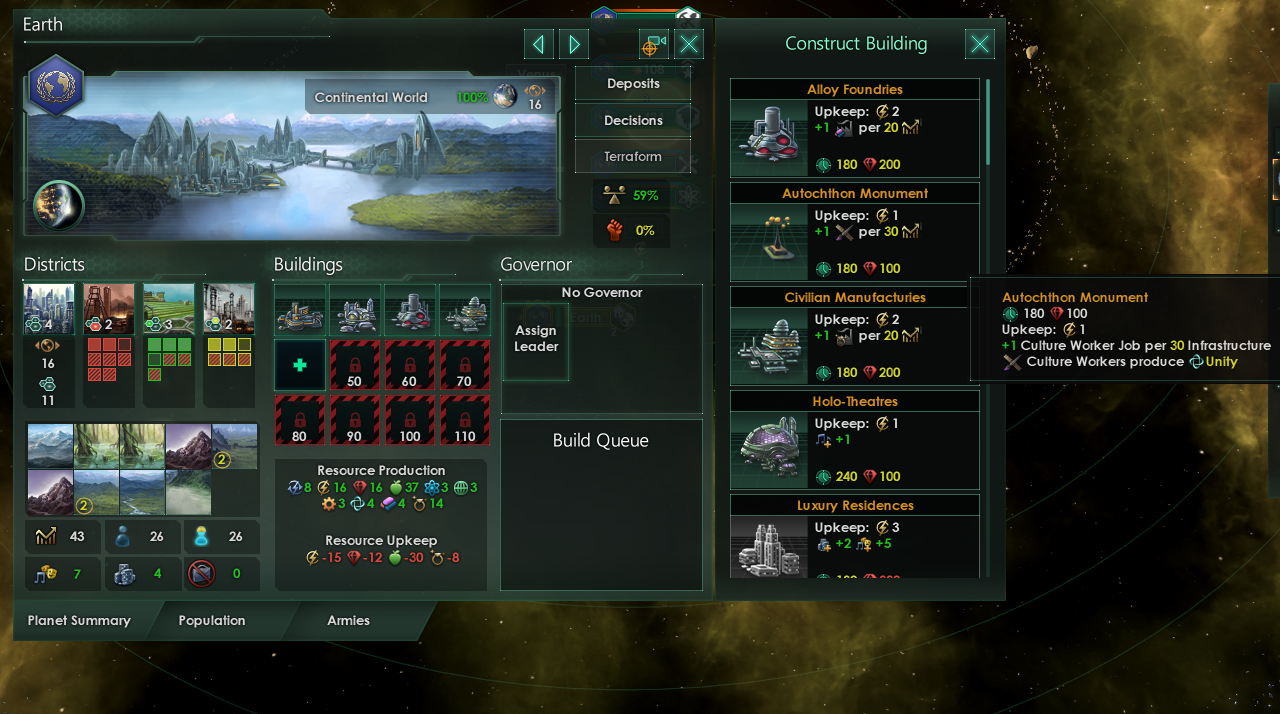
Whew, that was a lot of words. Still, we're only just getting started on the Planetary Rework and next week we'll continue talking about it, on the topic of Stratas, Pop Jobs, Housing and Migration.
Minimum Setup
- OS: Ubuntu 20.04 x64
- Processor: Intel iCore i3-530 or AMD FX-6350Memory: 4 GB RAM
- Memory: 4 GB RAM
- Graphics: Nvidia GeForce GTX 460 or AMD ATI Radeon HD 5870 (1GB VRAM). or AMD Radeon RX Vega 11 or Intel HD Graphics 4600Network: Broadband Internet connection
- Storage: 12 GB available space
Recommended Setup
- OS: Ubuntu 20.04 x64
- Processor: Intel iCore i5-3570K or AMD Ryzen 5 2400GMemory: 4 GB RAM
- Graphics: Nvidia GeForce GTX 560 Ti (1GB VRAM) or AMD Radeon R7 370 (2 GB VRAM)Network: Broadband Internet connection
- Storage: 12 GB available space
[ 6469 ]
[ 2503 ]
[ 1972 ]

